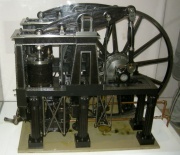
Temple Mill, Marshall Street, Holbeck, Leeds. Marshall and Co
Built in 1840 by Bonomi and David Roberts for John Marshall. David Roberts actually went off to the Temple of Karnak on the Nile to learn Egyptian Flax working, and returned to build the Temple Mill for John Marshall. Cast iron columns held up the ceiling and doubled as drain pipes. The ceiling itself had large domed skylights. The design of the building had a destinctly Egyptian feel and even the original chimney was an Egyptian Obelisk! Sadly this cracked and had to be replaced by a more conventional Victorian stack.
When John Marshall died, his flax business went into decline and ceased trading altogether in 1886.
Temple Works was based on the Temple of Edfu at Horus in Egypt, with a chimney designed in the style of an obelisk; at the time, it was said to be the largest single room in the world.
Employees at Temple Works worked 72 hours a week, 40% of the people employed by Marshall were young women aged thirteen to twenty, and about 20% were under thirteen. Conditions in the flax mills of that era were extremely hot and humid, humid conditions making the flax easier to work. Despite the age of his workers and the conditions in his factories, Marshall is considered to be one of the most liberal factory owners of the industrial revolution. In his factories, overseers were not allowed to use corporal punishment on the workers. Younger children were encouraged to attend day school, and older children were given free education on Monday afternoons.
1842 The recently built mill consists of one room, 396 feet long by 216 feet wide, covering nearly two acres of ground. The roof is formed of brick groined arches 21 feet high by 36 feet span,upon cast-iron pillars: an impermeable covering of coal-tar and lime is laid on a coating of rough plaster over the arches, and upon that is a layer of earth 8 inches thick, sown with grass.
1840 Beam Engine
The Egyptian theme even extended to the mill's steam engine. Built by Benjamin Hick and Sons, it was a double beam engine driving the machinery through one geared flywheel of 26 ft diameter. Two 54" cylinders, 5 ft stroke, 15 psi, 19 rpm. A fine model of the engine is displayed in the London Science Museum.
Note: An architecturally similar but somewhat more restrained 'Egyptian themed' engine by Hick, Hargreaves and Co may be seen, partly reconstructed, at Armley Mill Museum









